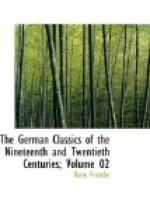They followed the crowd who had slowly ascended, and were now forming a circle round the spot where the future house was to stand. The lord of the castle, his family, and the principal strangers were now invited to descend into the vault, where the foundation-stone, supported on one side, lay ready to be let down. A well-dressed mason, a trowel in one hand and a hammer in the other, came forward, and with much grace spoke an address in verse, of which in prose we can give but an imperfect rendering.
“Three things,” he began, “are to be looked to in a building—that it stand on the right spot; that it be securely founded; that it be successfully executed. The first is the business of the master of the house—his and his only. As in the city the prince and the council alone determine where a building shall be, so in the country it is the right of the lord of the soil that he shall say, ’Here my dwelling shall stand; here, and nowhere else.’”
Edward and Ottilie were standing opposite one another, as these words were spoken; but they did not venture to look up and exchange glances.
“To the third, the execution, there is neither art nor handicraft which must not in some way contribute. But the second, the founding, is the province of the mason; and, boldly to speak it out, it is the head and front of all the undertaking—a solemn thing it is—and our bidding you descend hither is full of meaning. You are celebrating your Festival in the deep of the earth. Here within this small hollow spot, you show us the honor of appearing as witnesses of our mysterious craft. Presently we shall lower down this carefully-hewn stone into its place; and soon these earth-walls, now ornamented with fair and worthy persons, will be no more accessible—but will be closed in forever!
“This foundation-stone, which with its angles typifies the just angles of the building, with the sharpness of its molding, the regularity of it, and with the truth of its lines to the horizontal and perpendicular, the uprightness and equal height of all the walls, we might now without more ado let down—it would rest in its place with its own weight. But even here there shall not fail of lime and means to bind it. For as human beings who may be well inclined to each other by nature, yet hold more firmly together when the law cements them, so are stones also, whose forms may already fit together, united far better by these binding forces. It is not seemly to be idle among the working, and here you will not refuse to be our fellow-laborer;” with these words he reached the trowel to Charlotte, who threw mortar with it under the stone—several of the others were then desired to do the same, and then it was at once let fall. Upon which the hammer was placed next in Charlotte’s, and then in the others’ hands, to strike three times with it, and conclude, in this expression, the wedlock of the stone with the earth.




